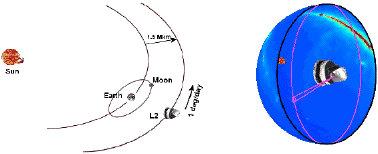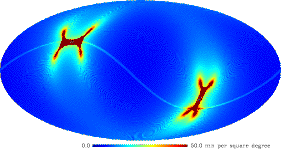OK, this is going to be very technical. In his comment to my last post, my colleague Ned Wright asks a couple of important questions about the way that the Planck Surveyor satellite is going to observe the sky. In the spirit of Mark Trodden’s question about the use of blogs in the research process, let’s see if we can answer these questions in a way that will satisfy Ned (who knows more about observing the CMB than most people on the planet) and not be completely opaque to the rest of my readers. Ned asks:
What is the current plan for the Planck scan pattern? I see this quote from the 2005 Blue Book:
The spacecraft will spin at 1 rpm around an axis offset by 85 degrees from the telescope boresight, so that the observed sky patch will trace a large circle on the sky (Dupac and Tauber, Astronomy & Astrophysics 430, 363, 2005)….
As the spin axis follows the Sun, the circle observed by the instruments sweeps through the sky at a rate of 1 degree/day. The whole sky will be covered (by all feeds) in a little more than 6 months; this operation will be repeated twice, resulting in a mission lifetime of around 15 months.
This describes a terrible scan pattern that may ruin Planck’s ability to measure the low-ell polarization signal that is essential for deterimining tau.
And the claim of covering the whole sky is wrong since as described, a 5 degree radius about each ecliptic pole is left out. That’s most of the sky, but not all.
The inner quote describes the way Planck will scan the sky — every minute, the satellite will observe a circle with an opening of twice the 85 degree angle described in the quote (a great circle that goes through the poles would have twice 90 degrees). Here’s a picture (from Dupac and Tauber 2005) of Planck’s location and the way it will scan the sky:

Ned is worried about two things, but I’ll discuss them in the opposite order.
He points out that the scan strategy leaves “holes” about five degrees across in the North and South poles. Indeed, the so-called “nominal” scan strategy above does suffer from this (although this is somewhat ameliorated by the fact that Planck has many detectors all looking at spots up to eight degrees from one another on the sky, so in fact those holes are largely filled). A more realistic scan strategy, as described in the paper by Dupac and Tauber mentioned above, will dip up and down out of the plane defined by pointing away from the sun, earth and moon. The exact way we perform these dips (how quickly and with what pattern) remains to be decided, but in any event will fill in those holes. For one possible strategy, the coverage looks like the following, from the same paper (yellow and red areas are observed more than blue and green):

Second, and most important, are the effects of long-term drifts in our detectors. An instrument like Planck can’t just look at a point in the sky and measure the temperature directly. Instead, the background level coming out of our detector is drifting over time, and these drifts can actually be large compared to the tiny CMB signal we’re trying to measure (for aficionados, this is often known as 1/f noise, after the power spectrum of the noise often observed in cases like this). This means that it’s relatively easy to measure the relative temperature of points that are observed nearby in time — since the background hasn’t drifted by much. But it’s much more difficult to measure relative temperatures over long periods of time. Therefore (as Ned points out), it might be difficult to observe patterns on large angular scales, across many individual rings. This is “the low-ell polarization signal that is essential for deterimining tau”: only on these scales can we observe the effects on the CMB of the very first objects to “light up”, more than twelve billion years ago.
This difficulty can only be ameliorated by “cross-linking” — making sure that you observe the same point at many different times. This lets us recalibrate the baseline of the detector every time we revisit that point or, better, set of points. The experiments that Ned Wright himself has worked on, COBE/DMR and WMAP, cleverly achieve this by the very complicated way they observe the sky.
Planck will definitely have a harder time, since its cross-linking only occurs at those points near the poles with many repeated observations. This puts a strong constraint on our detectors: they can’t drift very much over the one minute it takes to make a single circular scan. In this article, my Planck colleagues Christopher Cantalupo, Julian Borrill & Radek Stompor show that we can indeed handle these problems for more-or-less realistic kinds of noise.
To be sure, the real world is always more complicated than our simulations. The hard part will be dealing with what we euphemistically call “systematic effects” — roughly speaking, those errors that we don’t know how to describe very well, or that we don’t know about when we first fly the satellite. The ability to find these systematic effects is another reason why we want both very small known sources of error and the greater redundancy afforded by cross-linking, by comparing the same signal seen under very different conditions at different times during the mission.
Undoubtedly, we will encounter such unexpected sources of noise when we confront real data from Planck late next year, but we hope that the quality of our detectors, combined with the design of our scan strategy, will give us enough extra information to account for these inevitable problems. (But I probably won’t be able to tell you for sure until about 2011 when we’re due to make our first release of Planck results!)
Update: Further comments from Ned below. Discretion being the better part of valor, I shan’t comment on why these decisions have been left until now (although it is certainly arguable that flexibility is a good thing), and why Ned himself wasn’t consulted (suffice to say I wasn’t a member of the team that far back). However I must certainly agree that Planck’s ability to measure the polarization of the CMB would certainly be better if, as he suggests, the scan strategy visited pixels from many different directions, rather than approximately along lines of “longitude”; the measurement of polarization depends on just those directions, and having many different such measurements at the same location would make it easier to account for the aforementioned 1/f noise and possible systematic effects. Indeed, the experience of the WMAP team teaches us the difficulties of the measurement of large-scale polarization. We do believe that our raw sensitivity will be such that we can recover this polarization sufficiently accurately, but the proof will be in our results, and not in any simulations we do beforehand.
2 responses to “Planck scanning strategy”
I think that such a fundmental part of the mission design as the scan strategy should have been set in 1994 instead of floating around until 2008. The very old choice of no reaction wheels severely limits the current range of options.
And for polarization one really wants to scan through a given spot on the sky in many different directions. Planck will scan through a given spot with polarizers in many different orientations but they will be on different detectors. This imposes even harder requirements on the calibration and stability of the detectors.
I would have made a different choice back in the 90’s but I wasn’t asked. See “Scanning and Mapping Strategies for CMB Experiments”
Any one knows the result of the Planck Surveyor?